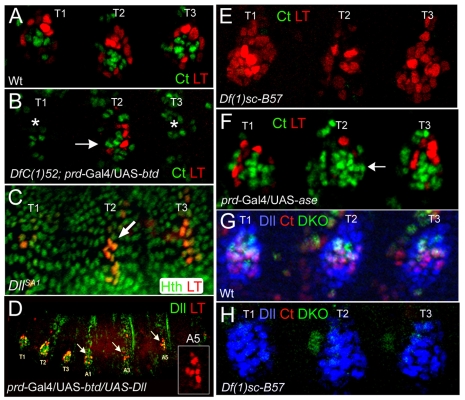Fig. 4.
Regulation of DKO and LT. (A) Wild-type stage 14 limb primordia stained for LT activity (red) and Ct (green). LT activity and Ct are present in mutually exclusive domains. (B) A stage 14 prd>btd; DfC(1)52 embryo stained for LT (red) and ct (green). In the absence of btd and Sp1 both LT and ct are not activated (in T1 and T2; asterisks). Resupplying Btd in T2 rescues LT and ct activity (arrow). (C) In a stage 14 DllSA1 mutant embryo LT activity (red) initiates, but decays over time. Unlike in wild type (A), the LT expression domain is a stripe. (D) Ectopic expression of Dll (green) and Btd using prd-Gal4 activates LT (red) in the abdomen (arrows). The inset shows ectopic activation of LT in abdominal segment 5. (E) A Df(1)sc-B57 mutant embryo, deleted for the ASC, stained for LT activity (red) and Ct (green). LT activity is expanded at the expense of the ct-expressing cells, which are lost. (F) Ectopic expression of the proneural gene asense (ase) in T2 represses LT activity (red) and expands the number of cells that express ct (green; arrow). (G) Wild-type limb primordia stained for Dll (blue), DKO activity (green) and Ct (red). DKO activity and Ct expression overlap within the Dll-positive domain. (H) Df(1)sc-B57 mutant embryo stained for DKO activity (green), Ct (red) and Dll (blue). DKO activity and Ct staining are absent in the leg primordia, but the number of cells expressing Dll is not changed.

